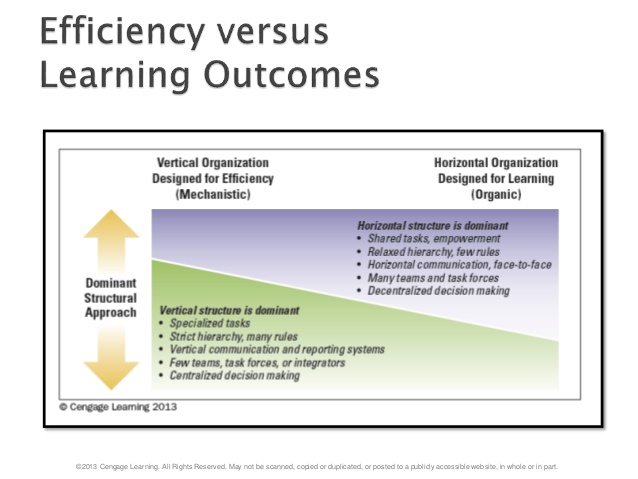Creating the Ideal Structure
Information-Sharing Perspective on Organization Structure
Organization structureOpens in new window is an important tool that helps companies executes their strategies and achieves their goals. Therefore, an organization structure should be designed to provide both verticalOpens in new window and horizontal informationOpens in new window flow as necessary to accomplish the organization’s overall goals.
If the structure doesn’t fit the information requirements of the organization, people either will have too little information or will spend time processing information that is not vital to their tasks, thus reducing effectiveness.
However, there is an inherent tension between vertical and horizontal mechanisms in an organization. Whereas vertical linkages are designed primarily for control, horizontal linkages are designed for coordination and collaboration, which usually means reducing control.
Centralized Versus Decentralized
One question is the level at which decisions are made in the organization, because that determines where information is needed. Centralization and decentralization pertain to the hierarchical level at which decisions are made.
- Centralization means that decision authority is located near the top of the organization.
- With decentralization, decision authority is pushed downward to lower organizational levels.
OrganizationsOpens in new window can choose whether to orient toward a traditional organization designed for efficiency, which emphasizes vertical communication and controlOpens in new window (a mechanistic designOpens in new window), or toward a contemporary flexible learning organization, which emphasizes horizontal communication and coordinationOpens in new window (an organic designOpens in new window).
Figure X-3 compares organizations designed for efficiency with those designed for learning and adaptation.
 Figure X-3 The Relationship of Organization Design to Efficiency Versus Learning Outcomes | Credit — Slide Share Opens in new window
Figure X-3 The Relationship of Organization Design to Efficiency Versus Learning Outcomes | Credit — Slide Share Opens in new window
The traditional vertical organization is designed primarily for efficiency while a strong horizontal organization is designed primarily for learning and flexibility.
An emphasis on efficiency and control is associated with:
- specialized tasks,
- a hierarchy of authority,
- rules and regulations,
- formal reporting systems,
- few teams or task forces, and
- centralized decision making.
Emphasis on learning and adaptation is associated with:
- shared tasks,
- a relaxed hierarchy,
- few rules,
- face-to-face communication,
- many teams and task forces, and
- informal, decentralized decision making.
OrganizationsOpens in new window may have to experiment to find the correct degree of centralization or decentralization to meet their needs.
For example, a study by William Ouchi found that three large districts that shifted to a more flexible, decentralized structure, giving school principals more autonomy, responsibility, and control over resources, performed better and more efficiently than large districts that were highly centralized.
Government leaders in Great Britain hope the same thing will happen when they decentralize the country’s National Health ServiceOpens in new window.
The system is undergoing the most radical restructuring since it was founded in 1948, with a key part of the plan to shift control of the multibillion dollar annual healthcare budget to doctors at the local level.
Leaders believe decentralization will cut costs, simplify and streamline procedures, and reduce inefficiency by “putting power in the hands of patients and clinicians.”
Even Japanese companies such as Toyota, which have a strong tradition of centralization, are seeing the power of decentralization for promoting a sense of ownership.
However, not every organization should decentralize all decisions. Within many companies, there is often a “tug of war between centralization and decentralization” as top executives want to centralize some operations to eliminate duplication, while business managers want to maintain decentralized control.
Managers are always searching for the best combination of vertical controlOpens in new window and horizontal collaborationOpens in new window, centralization and decentralization, for their own situations.
The series:
- Research data for this work have been adapted from the manual:
- Organization Theory & Design By Richard L. Daft

